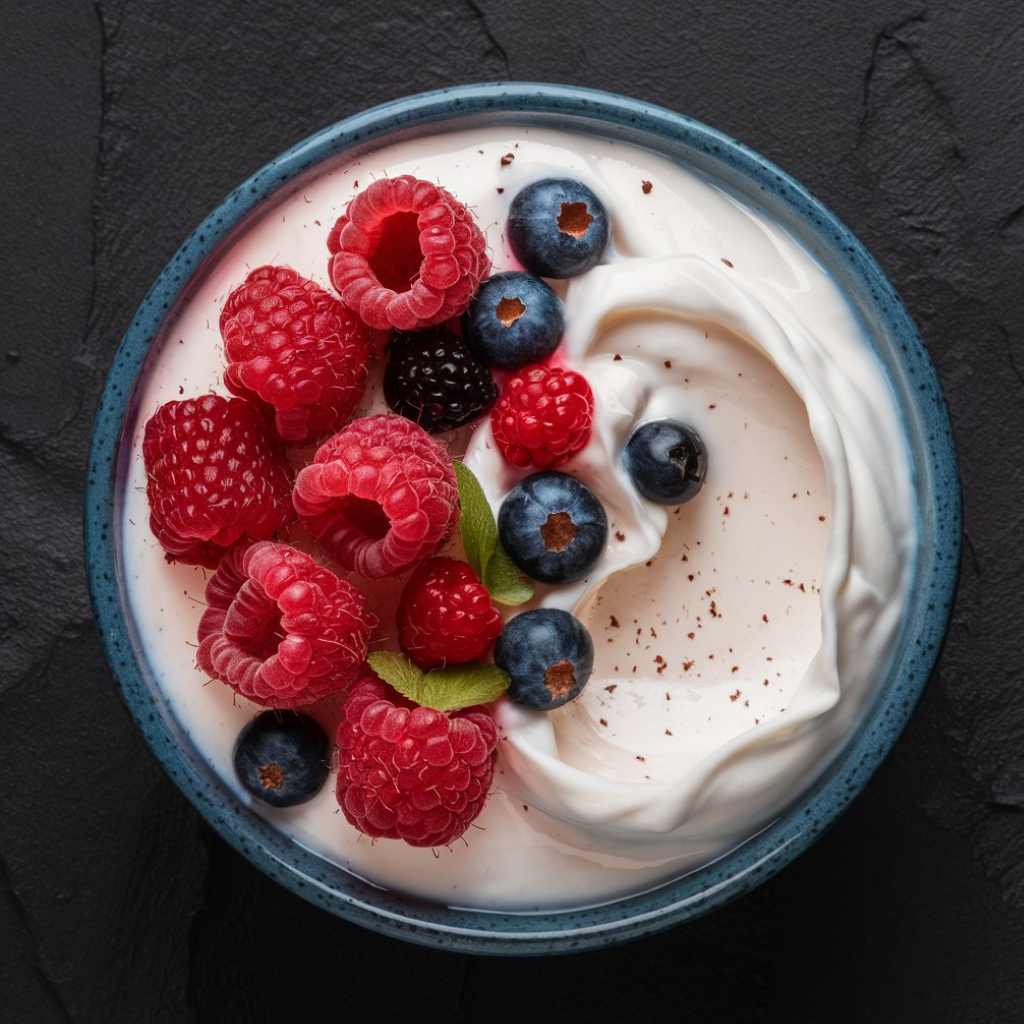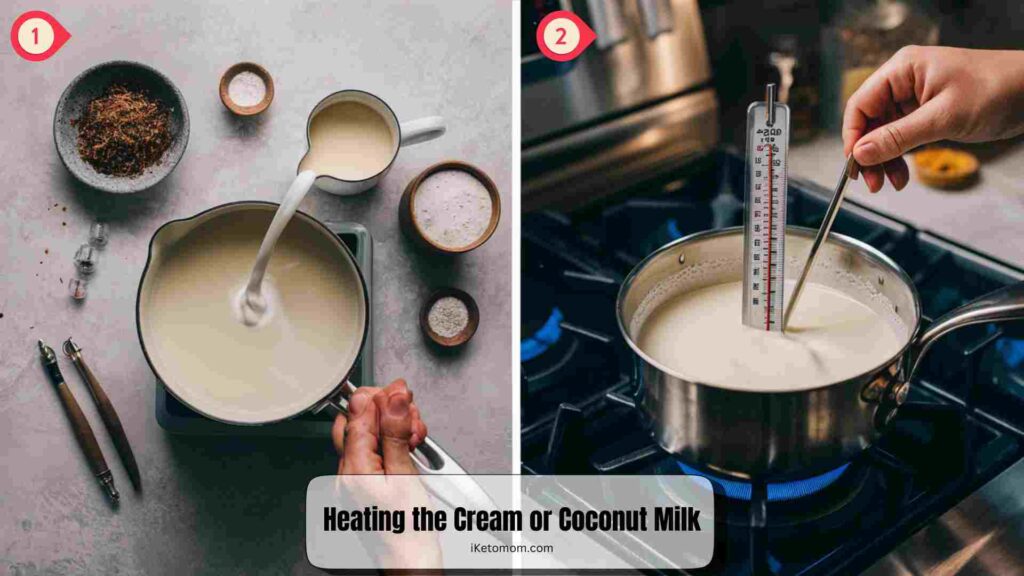Keto Yogurt emerges as a suitable and nutritious option within the framework of the ketogenic lifestyle. Unlike traditional yogurt varieties that may contain significant amounts of carbohydrates from sugars or fruits, keto yogurt is crafted using ingredients that are low in carbs and rich in healthy fats.
Typically made from heavy cream or full-fat coconut milk and a yogurt starter culture or probiotics, keto yogurt provides a creamy and satisfying alternative that aligns perfectly with the low-carb, high-fat principles of the keto diet.
For individuals following a ketogenic lifestyle, keto yogurt offers a convenient and delicious way to enjoy the goodness of yogurt while staying within their dietary goals. It can be enjoyed plain, customized with keto-friendly toppings, or used as an ingredient in various keto-friendly recipes. Keto yogurt’s nutritional profile, along with its versatility and flavor options, makes it a valuable addition to the keto diet, supporting overall health and wellness for those embracing this dietary approach.
Keto Friendly Yogurt Recipe
Ingredients
1. Heavy Cream or Full-Fat Coconut Milk:
- Heavy cream is a rich, high-fat dairy product that is commonly used to make keto-friendly yogurt. It provides a creamy texture and is low in carbohydrates.
- Full-fat coconut milk is an excellent dairy-free alternative for those following a ketogenic or dairy-free diet. It’s rich in healthy fats and provides a creamy consistency similar to heavy cream.
2. Yogurt Starter Culture or Probiotic Capsules:
- A yogurt starter culture contains live bacteria strains, such as Lactobacillus bulgaricus and Streptococcus thermophilus, which are essential for fermenting the cream or coconut milk and turning it into yogurt.
- Probiotic capsules can also be used as an alternative to a yogurt starter culture. Make sure to choose capsules that contain live cultures suitable for yogurt fermentation.
3. Keto-Friendly Sweeteners (Optional):
- Keto-friendly sweeteners are used to add sweetness to the yogurt without adding significant carbohydrates. Common keto-friendly sweeteners include stevia, erythritol, monk fruit extract, or blends of these sweeteners.
- It’s important to use sweeteners that do not spike blood sugar levels and are suitable for a ketogenic diet.
4. Flavorings like Vanilla Extract (Optional):
- Flavorings like vanilla extract, cocoa powder, or fruit extracts can be added to enhance the taste of keto-friendly yogurt.
- Be mindful of the carb content of flavorings and choose options that are low in carbohydrates or sugar-free to maintain the keto-friendly nature of the yogurt.
These ingredients are key components of keto yogurt and can be combined to create a delicious and nutritious low-carb, high-fat yogurt option suitable for those following a ketogenic diet. Adjust the quantities and flavors according to your preferences to enjoy a personalized keto-friendly yogurt experience.
Instructions
1. Heating the Cream or Coconut Milk:
- Pour 4 cups of heavy cream or full-fat coconut milk into a saucepan.
- Place the saucepan over medium heat and bring the cream or coconut milk to a gentle simmer, stirring occasionally.
- Use a thermometer to monitor the temperature. Heat the mixture until it reaches around 110°F (43°C), which is the optimal temperature for activating the yogurt starter culture or probiotics. Avoid boiling the mixture.
2. Adding the Yogurt Starter Culture or Probiotics:
- Once the cream or coconut milk reaches the desired temperature, remove it from heat.
- Add 2 tablespoons of yogurt starter culture to the warm cream or open 2 probiotic capsules and sprinkle the contents into the mixture.
- Use a whisk or spoon to thoroughly mix the starter culture or probiotics into the cream or coconut milk until fully dissolved.
3. Fermenting the Mixture:
- Transfer the mixture into a yogurt maker or Instant Pot with a yogurt function.
- Follow the manufacturer’s instructions for setting the fermentation time. Typically, ferment the mixture for 8 to 12 hours to allow the yogurt cultures to grow and thicken the mixture.
- Keep the lid closed during fermentation to maintain a consistent temperature.
4. Optionally Sweetening and Adding Flavorings:
- After the fermentation period, taste the yogurt to determine if additional sweetness is desired.
- If desired, add keto-friendly sweeteners such as stevia or erythritol to the yogurt and mix well until the sweeteners are fully incorporated.
- You can also add flavorings like a splash of vanilla extract or a sprinkle of cocoa powder to enhance the flavor of the yogurt. Mix thoroughly.
5. Storing the Yogurt:
- Once sweetened and flavored (if desired), transfer the yogurt into clean, airtight storage containers.
- Seal the containers tightly and refrigerate the yogurt for at least 2 to 4 hours to allow it to chill and further thicken.
- After chilling, the keto-friendly yogurt is ready to be enjoyed.
The instructions for making keto yogurt involve heating heavy cream or coconut milk, adding a yogurt starter culture or probiotics, fermenting the mixture, optionally sweetening and adding flavorings, and storing the yogurt in the refrigerator. This process ensures that the yogurt is low in carbohydrates, high in healthy fats, and contains beneficial probiotics for gut health. By following these steps, you can create a creamy and flavorful yogurt that aligns with the principles of a ketogenic diet, offering a satisfying and nutritious option for breakfast or snacks.
Keto yogurt is a low-carbohydrate, high-fat variation of traditional yogurt specifically designed to fit into a ketogenic diet. Unlike regular yogurt, which can be high in carbohydrates due to added sugars or fruit, keto yogurt is made with ingredients that are low in carbs and high in healthy fats. Common ingredients used in keto yogurt include heavy cream or full-fat coconut milk, yogurt starter culture or probiotics, and optionally, keto-friendly sweeteners and flavorings.
The process of making keto yogurt involves heating the cream or coconut milk, adding the yogurt starter culture or probiotics, and fermenting the mixture in a yogurt maker or Instant Pot. Optionally, sweeteners like stevia or erythritol and flavorings like vanilla extract can be added to enhance the taste.
Keto Yogurt Nutrition Info
A basic nutrition table for Keto Yogurt, based on standard serving sizes and ingredients:
| Nutrient | Amount per Serving |
|---|---|
| Calories | 200 kcal |
| Total Fat | 18g |
| – Saturated Fat | 12g |
| Cholesterol | 70mg |
| Sodium | 30mg |
| Total Carbohydrates | 2g |
| – Dietary Fiber | 0g |
| – Sugars | 1g |
| Protein | 5g |
This nutrition table provides a general idea of the nutrient content in a serving of keto yogurt. Keep in mind that the actual nutrient content may vary based on the specific ingredients and quantities used in the recipe.
Here’s a combined nutrition table for each ingredient commonly used in keto yogurt:
| Ingredient | Serving Size | Calories | Total Fat | Saturated Fat | Cholesterol | Sodium | Total Carbohydrates | Dietary Fiber | Sugars | Protein |
|---|---|---|---|---|---|---|---|---|---|---|
| Heavy Cream | 1 cup (240ml) | 821 kcal | 88g | 55g | 326mg | 89mg | 7g | 0g | 7g | 5g |
| Full-Fat Coconut Milk | 1 cup (240ml) | 552 kcal | 57g | 50g | 0mg | 33mg | 7g | 2g | 5g | 5g |
| Yogurt Starter Culture | Varies | Varies | Varies | Varies | Varies | Varies | Varies | Varies | Varies | Varies |
| Probiotic Capsules | Varies | Varies | Varies | Varies | Varies | Varies | Varies | Varies | Varies | Varies |
| Keto-Friendly Sweeteners | 1 teaspoon | 0 kcal | 0g | 0g | 0mg | 0mg | 1g | 0g | 0g | 0g |
| Vanilla Extract (Flavorings) | 1 teaspoon | 12 kcal | 0g | 0g | 0mg | 0mg | 0.6g |
This table provides a comprehensive overview of the nutritional content of each ingredient commonly used in keto-friendly yogurt, based on standard serving sizes. Please note that the nutritional values for yogurt starter culture, probiotic capsules, and specific sweeteners can vary and may not be listed in detail due to their variability. It’s important to check product labels or nutritional information for accurate data.
Tips for Best Results 🍽
Here are some tips for achieving the best results when making keto-friendly yogurt:
- Choose High-Quality Ingredients: Use high-quality heavy cream or full-fat coconut milk for the base of your yogurt. Look for products without added sugars or fillers.
- Use Fresh Yogurt Starter Culture or Probiotics: Ensure that your yogurt starter culture or probiotic capsules are fresh and contain live cultures. This is essential for successful fermentation.
- Monitor Temperature: Use a thermometer to accurately monitor the temperature when heating the cream or coconut milk. Heating it to around 110°F (43°C) is optimal for activating the yogurt cultures.
- Follow Fermentation Guidelines: Follow the recommended fermentation time for your yogurt maker or Instant Pot. Typically, fermenting for 8 to 12 hours at a consistent temperature yields the best results.
- Avoid Disturbing the Mixture: Once you’ve added the yogurt starter culture or probiotics and transferred the mixture to the fermentation device, avoid stirring or disturbing it unnecessarily. This helps the cultures ferment properly.
- Optimize Flavor: If adding sweeteners and flavorings, do so after the fermentation process and when the yogurt has cooled slightly. This allows the flavors to blend well without affecting the fermentation.
- Chill Before Serving: For best texture and flavor, refrigerate the yogurt for a few hours after fermentation to allow it to chill and thicken. Stir the yogurt before serving if needed.
- Experiment with Variations: Don’t be afraid to experiment with different flavor variations and toppings to suit your taste preferences. Keto-friendly toppings like berries, nuts, or seeds can add variety and nutrition.
By following these tips, you can enhance the quality and flavor of your keto-friendly yogurt and enjoy a creamy, satisfying treat that aligns with your low-carb, high-fat dietary goals.

Keto Friendly Yogurt Recipe
Equipment
- Saucepan For heating the cream or coconut milk to the required temperature.
- Thermometer To accurately measure the temperature of the cream or coconut milk. A digital kitchen thermometer works well for this purpose.
- Yogurt Maker or Instant Pot with Yogurt Function To ferment the yogurt mixture at a controlled temperature for the specified duration. Some Instant Pot models have a yogurt function that can be used for this purpose.
- Whisk or Spoon For mixing the yogurt starter culture or probiotic capsules into the heated cream or coconut milk.
- Storage Containers Airtight containers for storing the fermented yogurt in the refrigerator once it has reached the desired consistency.
- Optional Equipment:
- Strainer If you prefer a thicker yogurt consistency, you can use a fine-mesh strainer or cheesecloth to strain the yogurt after fermentation.
- Sweetener Dispenser If you plan to sweeten the yogurt with keto-friendly sweeteners like stevia or erythritol, a dispenser or measuring spoon for the sweetener can be helpful.
Ingredients
- 4 Cups Heavy Cream or full-fat coconut milk
- 2 Tablespoons Yogurt Starter Culture or Probiotic Capsules (containing live cultures)
Optional:
- Keto-friendly sweeteners such as stevia or erythritol, to taste
- Optional flavorings such as vanilla extract or cocoa powder, to taste
Instructions
- Heating the cream or coconut milk in a saucepan until it reaches around 110°F (43°C).
- Adding the yogurt starter culture or probiotic capsules and mixing well.
- Transferring the mixture to the yogurt maker or Instant Pot and setting it to ferment for 8-12 hours.
- Checking the yogurt's consistency and refrigerating it for a few hours to thicken further.
- Optionally, sweetening the yogurt with keto-friendly sweeteners and adding flavorings like vanilla extract or cocoa powder.
Notes
Delicious Topping Ideas
Here are some delicious topping ideas for keto-friendly yogurt:
1. Berries
Opt for low-carb berries like raspberries, strawberries, or blackberries. They add natural sweetness and a burst of flavor without spiking carb levels significantly.
2. Nuts and Seeds
Sprinkle chopped almonds, walnuts, pecans, or pumpkin seeds for added crunch and healthy fats. These toppings also provide essential nutrients like omega-3 fatty acids.
3. Nut Butter
Add a dollop of almond butter, peanut butter (if not sensitive to legumes), or sunflower seed butter for a creamy texture and extra pro
4. Coconut Flakes
Toasted coconut flakes add a delightful tropical flavor and a satisfying crunch. Look for unsweetened varieties to keep it keto-friendly.
5. Cacao Nibs
For a chocolatey twist, sprinkle cacao nibs on top of your yogurt. They’re rich in antioxidants and provide a pleasant cocoa flavor.
6. Chia Seeds or Flaxseeds
Boost the fiber content of your yogurt with chia seeds or ground flaxseeds. They also add a thick, pudding-like texture when soaked in the yogurt.
7. Keto Granola
Make or purchase a keto-friendly granola made with nuts, seeds, coconut, and a sugar-free sweetener. It adds a crunchy and flavorful topping to your yogurt.
8. Sugar-Free Syrups
Explore sugar-free syrups like sugar-free maple syrup or keto-friendly fruit-flavored syrups for a touch of sweetness without the carbs.
9. Spices
Sprinkle a pinch of cinnamon, nutmeg, or cardamom on top of your yogurt for a warm and aromatic flavor profile.
10. Vanilla Whipped Cream
Whip heavy cream with a dash of vanilla extract and keto-friendly sweetener to create a light and fluffy topping for your yogurt.
These topping ideas can be mixed and matched to create a variety of delicious combinations, adding excitement and flavor to your keto-friendly yogurt while keeping it low in carbohydrates.
FAQ
Is Yogurt Keto?
Traditional yogurt can vary in its keto-friendliness depending on its carbohydrate content. Many commercial yogurts contain added sugars or fruit, which can significantly increase the carb content and make them less suitable for a strict ketogenic diet. However, there are keto-friendly yogurt options available that are specifically formulated to be low in carbs and high in healthy fats.
Keto-friendly yogurt is typically made from ingredients like heavy cream or full-fat coconut milk, which are low in carbs and rich in fats. These yogurts often contain minimal added sugars or use keto-friendly sweeteners to achieve sweetness without spiking blood sugar levels.
When selecting yogurt for a keto diet, it’s essential to check the nutrition label for the carbohydrate content, particularly sugars and added sugars. Opt for yogurts that are labeled as “keto-friendly,” “low-carb,” or “sugar-free” to ensure they align with your dietary goals.
Ultimately, yogurt can be keto-friendly if it is made with low-carb ingredients and fits within your daily carbohydrate allowance on the ketogenic diet.
Is Greek Yogurt Keto?
Greek yogurt can be a part of a ketogenic diet depending on its specific nutritional content. Traditional Greek yogurt is lower in carbohydrates compared to regular yogurt because it undergoes a straining process that removes some of the lactose (milk sugars).
Here are some points to consider regarding Greek yogurt and its keto-friendliness:
- Carbohydrate Content: Greek yogurt typically contains fewer carbohydrates than regular yogurt, making it a better option for those following a low-carb or ketogenic diet. However, the exact carb content can vary among brands and varieties, so it’s essential to check the nutrition label.
- Protein Content: Greek yogurt is higher in protein compared to regular yogurt due to its concentrated nature. This can be beneficial for those on a ketogenic diet as it helps with satiety and muscle maintenance.
- Fat Content: While traditional Greek yogurt is not as high in fat as some keto-friendly dairy options like heavy cream or full-fat coconut milk, you can opt for full-fat or higher-fat versions of Greek yogurt to increase the fat content.
- Added Sugars: Be cautious of flavored or sweetened Greek yogurts, as they may contain added sugars that can increase the carb content. Choose plain, unsweetened Greek yogurt and add your own keto-friendly sweeteners or flavorings if desired.
In summary, plain Greek yogurt can be keto-friendly due to its lower carbohydrate content and higher protein content compared to regular yogurt. However, it’s essential to select options without added sugars and to consider your overall daily carbohydrate intake when including Greek yogurt in your ketogenic meal plan.
Is zero sugar yogurt keto?
Zero sugar yogurt can be keto-friendly, but it depends on the overall carbohydrate content and ingredients. Here are some key points to consider:
- Carbohydrate Content: While zero sugar yogurt indicates that it doesn’t contain added sugars, it’s crucial to check the total carbohydrate content on the nutrition label. Some zero sugar yogurts may still contain carbohydrates from other sources, such as natural sugars in dairy or added sugar substitutes like erythritol or stevia.
- Sweeteners: Zero sugar yogurts often use sugar substitutes like erythritol, stevia, or monk fruit extract to provide sweetness without adding carbs. These sweeteners are generally considered keto-friendly because they have minimal impact on blood sugar and insulin levels.
- Ingredients: Check the ingredient list to ensure that the yogurt does not contain high-carb additives or fillers. Opt for plain or unsweetened varieties to have more control over the ingredients and avoid hidden carbs.
- Fat Content: For a yogurt to be more keto-friendly, it should also have a higher fat content. Full-fat or higher-fat versions of zero sugar yogurt are preferable for those following a ketogenic diet, as fat is a key component of the keto macronutrient ratio.
- Portion Size: Pay attention to serving sizes to ensure you’re not consuming excessive carbs, especially if the yogurt contains other ingredients like fruits or grains.
In summary, zero sugar yogurt can be keto-friendly if it is low in total carbohydrates, uses keto-friendly sweeteners, has a higher fat content, and does not contain high-carb additives. Always check the nutrition label and ingredient list to make informed choices that align with your ketogenic dietary goals.
Which yogurt is keto-friendly?
Several types of yogurt can be keto-friendly, depending on their specific nutritional content and ingredients. Here are some types of yogurt that are generally considered keto-friendly:
- Plain Greek Yogurt: Plain Greek yogurt is lower in carbohydrates compared to regular yogurt due to its straining process, which removes some of the lactose (milk sugars). Opt for full-fat or higher-fat versions without added sugars for a more keto-friendly option.
- Plain Regular Yogurt: Some plain regular yogurts, especially those labeled as low-fat or full-fat, can also be keto-friendly if they have minimal carbohydrates and no added sugars. Always check the nutrition label for carb content.
- Coconut Milk Yogurt: Yogurt made from full-fat coconut milk is naturally lower in carbs and higher in healthy fats, making it a suitable option for a ketogenic diet. Look for unsweetened varieties without added sugars.
- Almond Milk Yogurt: Similarly, yogurt made from almond milk can be keto-friendly if it’s low in carbs and free from added sugars. Check the label for carb content and avoid sweetened versions.
- Probiotic Yogurt: Some probiotic yogurts are specifically formulated to be low in carbs and sugar, making them suitable for keto diets. Look for varieties with minimal ingredients and no added sugars.
- Keto-Friendly Brands: There are several brands that specialize in keto-friendly yogurt options, often made with high-fat dairy or dairy alternatives and sweetened with keto-friendly sweeteners like erythritol or stevia. These yogurts are designed to fit within the macronutrient ratios of a ketogenic diet.
When choosing a keto-friendly yogurt, it’s essential to check the nutrition label for the following:
- Total carbohydrate content (aim for low-carb options)
- Sugar content (opt for zero or minimal added sugars)
- Fat content (higher fat is preferable for keto)
- Ingredients list (avoid high-carb additives or fillers)
Ultimately, the best keto-friendly yogurt for you will depend on your individual dietary preferences and tolerance for dairy or dairy alternatives.
How many carbs are in keto yogurt?
The carbohydrate content in keto-friendly yogurt can vary depending on the specific brand, type, and ingredients used. Generally, keto-friendly yogurts are designed to be low in carbs to fit within the macronutrient ratios of a ketogenic diet, which typically involves consuming around 20-50 grams of net carbs per day.
Here’s a general guideline for the carbohydrate content in keto yogurt:
- Plain, unsweetened Greek yogurt or full-fat coconut milk yogurt: These types of yogurts can have around 4-6 grams of net carbs per 100 grams (approximately 3.5 ounces) serving.
- Keto-friendly yogurt alternatives: Some specialty brands offer keto-specific yogurts that are even lower in carbs, often ranging from 1-3 grams of net carbs per serving (100 grams).
It’s essential to check the nutrition label on the yogurt packaging for accurate carbohydrate information. Look for yogurts labeled as “keto-friendly,” “low-carb,” or “sugar-free,” and always consider the serving size when calculating your carb intake. Additionally, be cautious of flavored or sweetened yogurts, as they may contain higher carbohydrate content due to added sugars or flavorings. Opt for plain varieties and add your own keto-friendly sweeteners or flavorings if desired.

I’m Priscilla Swahn, a registered dietitian with a master’s degree in nutritional sciences. With over a decade of experience in holistic nutrition, I specialize in creating delicious keto recipes to help you enjoy a healthy lifestyle. On iKetoMom, you’ll find a variety of recipes for every meal—hearty breakfasts, satisfying lunches, mouthwatering dinners, indulgent desserts, and refreshing drinks. My recipes make keto living easy and enjoyable for the whole family. Featured in EatingWell and MindBodyGreen, I also collaborate with health centers and corporate companies to share my expertise. Join me and discover the joy of keto cooking!






